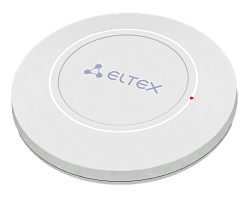Subscribe
You will receive on your e-mail all the news about the product, updating software and documentation!
Wireless access point WEP-2ac
Overview
Specifications
Reviews
Key benefits
WEP-2ac provides accessible, easy-to-use, high-performance and secure wireless network that combines numerous fea-tures and services required by corporate clients.
WEP-2ac is a universal solution for organization of wireless networks in highly crowded areas and high traffic environ-ments (offices, state institutions, conference halls, laborato-ries, hotels, etc.).
Wireless connection
Due to support for IEEE 802.11n/ac standards, the WEP-2ac access point provides 867 Mbps (at 5 GHz) and 300 Mbps (at 2.4 Ghz) data rates.
The use of MIMO technology and embedded omni-directional antennas makes WEP-2ac a universal solution for corporate networks constriction.
Security
WEP-2ac provides personal data protection and corporate en-vironment security due to the support for modern authenti-cation technologies. Particularly, it uses a dynamic key that is unique for each active client.
Performance
High-performance processors are used in the devices in order to provide reliability and high data processing rates.
Power supply
The PoE+ technology makes installation of the equipment pos-sible virtually everywhere, regardless of the power supply lo-cation. The use of PoE+ technology reduces total cost by dis-carding power cables and makes installation easier and faster.
- Dual band access point with support for 802.11ac (5G Wi-Fi)
- Power supply: PoE+ (IEEE 802.3at)
- Operation in a cluster without a dedicated server (up to 64 devices)
- Seamless roaming
- Up-to-date authentication and encryption means
WEP-2ac provides accessible, easy-to-use, high-performance and secure wireless network that combines numerous fea-tures and services required by corporate clients.
WEP-2ac is a universal solution for organization of wireless networks in highly crowded areas and high traffic environ-ments (offices, state institutions, conference halls, laborato-ries, hotels, etc.).
Wireless connection
Due to support for IEEE 802.11n/ac standards, the WEP-2ac access point provides 867 Mbps (at 5 GHz) and 300 Mbps (at 2.4 Ghz) data rates.
The use of MIMO technology and embedded omni-directional antennas makes WEP-2ac a universal solution for corporate networks constriction.
Security
WEP-2ac provides personal data protection and corporate en-vironment security due to the support for modern authenti-cation technologies. Particularly, it uses a dynamic key that is unique for each active client.
Performance
High-performance processors are used in the devices in order to provide reliability and high data processing rates.
Power supply
The PoE+ technology makes installation of the equipment pos-sible virtually everywhere, regardless of the power supply lo-cation. The use of PoE+ technology reduces total cost by dis-carding power cables and makes installation easier and faster.
Interfaces
Active channels1
Receiver sensitivity
Physical specifications
- 1 Ethernet port 10/100/1000Base-T (RJ-45)
- Console (RJ-45)
- Support for IEEE 802.11a/b/g/n/ac
- Data aggregation, including A-MPDU (Tx / Rx) и А-MSDU (Rx)
- WMM-based packet priorities and planning
- Dynamic frequency selection (DFS)
- Support for hidden SSID
- 32 virtual access points
- External access points detection
- APSD
- WDS
- Automatic speed negotiation, duplex mode negotiation and MDI/MDI-X switch-over
- VLAN support
- DHCP client
- LLDP support
- ACL support
- IPv6 support
- Cluster creation with the capacity of up to 64 access points
- Load balancing among access points
- Automatic synchronization of access points configurations in a cluster
- Single Management IP – a unified address for access points management in a cluster
- Automatic frequency channel allocation for multiple access points
- Authentication via RADIUS server
- Packet priorities and planning based on profiles
- Bandwidth limiting for each SSID
- Modification of WMM parameters for each radio interface
- Centralized authorization via RADIUS server (802.1X WPA/WPA2 Enterprise)
- WPA/WPA2 encryption
- Captive Portal support
- Authorization via RADIUS server at a login
- E-mail notifications on system events
- Frequency range 2400–2480.3 MHz; 5150–5350 MHz, 5470–5850 MHz
- BPSK, QPSK, 16QAM, 64QAM, 256QAM modulations
- Embedded omnidirectional antennas
- Support for 2х2 MIMO
- 802.11b/g/n: 1-13 (2412 - 2472 MHz)
- 802.11a/n/ac:
- 36-64 (5170 - 5330 MHz)
- 100-144 (5490 - 5730 MHZ)
- 149-165 (5735 - 5835 MHZ)
- 802.11n: 300 Mbps
- 802.11ac: 867 Mbps
- 2.4 GHz: up to 18 dBm2
- 5 GHz: up to 21 dBm2
Built-in antenna gain
- 2.4 GHz: up to 5 dBi
- 5 GHz: up to 5 dBi
- 2.4 GHz: up to -98 dBm
- 5 GHz: up to -94 dBm
Physical specifications
- Power consumption up to 13 W
- 128 MB NAND Flash
- 256 MB RAM DDR3
- Power supply: PoE+ 48 V/54 V (IEEE 802.3at-2009)
- Operating temperature from +5 Cо to +40 Cо
- Dimensions (diameter × height): 200 × 40 mm
- Software update and configuration via DHCP Autoprovisioning
- Remote management via Telnet, SSH
- Web interface
- SNMP


